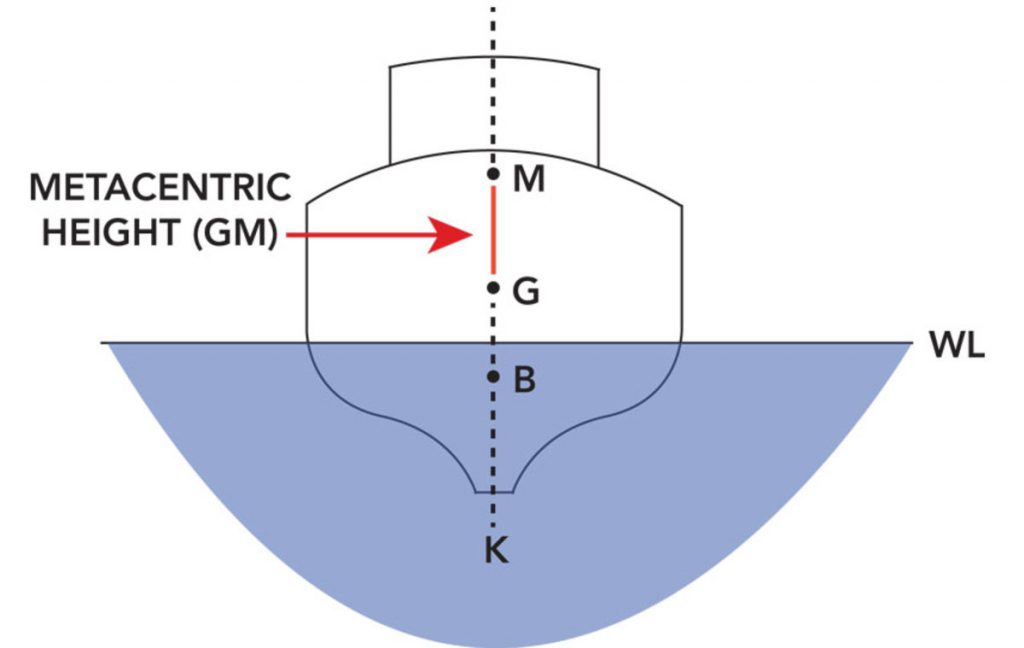What is Angle of Loll? Angle of List | What is Waterline | Definitions and Use of Block Coefficient
What is Angle of Loll? Angle of List | What is Waterline | Definitions and Use of Block Coefficient
Angle of Loll
The situation of a ship that is unstable when upright (i.e., has a negative metacentric height) and so takes on an angle of heel to either port or starboard is referred to as angle of loll.
When a vessel has negative metacentric height (GM), it is in unstable equilibrium and any external force applied to it causes it to heel.
As the vessel heels, the moment of inertia of the waterplane (a plane intersecting the hull at the water’s surface) grows, increasing the vessel’s BM, or distance from the center of buoyancy to the Metacenter.
Because the KB (distance from the Keel to the Center of Buoyancy) of the vessel changes relatively little, the KM (distance from the Keel to the Metacenter) of the vessel increases.
At some heel angle (say, 10°), KM will increase sufficiently to equal KG (distance from the keel to the center of gravity), making the vessel’s GM equal to zero.
When this happens, the vessel returns to neutral equilibrium, and the angle of heel at which it occurs is known as the angle of loll.
In other words, when an unstable vessel heels over towards a constantly rising angle of heel, the center of buoyancy (B) may fall vertically below the center of gravity at a particular degree of heel (G).
List angle should not be confused with loll angle. The angle of list is caused by unequal loading on each side of the vessel’s center line.
Although a vessel at an angle of loll exhibits elements of stable equilibrium, this is a perilous scenario that requires immediate corrective action to keep the vessel from capsizing.
It is frequently produced by the influence of a large free surface or the lack of stability as a result of broken compartments.
It differs from list in that the vessel is not encouraged to heel to one side or the other by weight distribution; rather, it is incapable of sustaining a zero-heel attitude.
Angle of List
The angle of list is the degree to which a vessel heels (leans or tilts) to either port or starboard when it is at rest and no external forces are acting on it.
Listing is produced by an unequal distribution of weight aboard as a result of uneven loading or flooding.
Roll, on the other hand, is the dynamic movement from side to side induced by waves. A listing ship will capsize and potentially sink if it goes past the point where a righting moment will keep it afloat.
Waterline
The waterline is the point at which a ship’s hull meets the surface of the water. It is also the name of a special marking, also known as an international load line, Plimsoll line.
The water line indicates the draft of the ship and the legal limit to which a ship may be loaded for specific water types and temperatures in order to safely maintain buoyancy, particularly with regard to the risk of waves.
Because warm water is less dense than cold water, it provides less buoyancy, varying water temperatures will impact a ship’s draft.
Similarly, fresh water is less dense than salinated or seawater, which has the same effect on buoyancy.
The hull speed of a vessel with a displacement hull is determined, among other things, by the waterline length.
The waterline length in a sailing boat can fluctuate dramatically when the boat heels, and this can have a dynamic effect on the boat’s speed.
When a ship is afloat in a normal state, the waterline can also refer to any line on its hull that is parallel to the water’s surface.
As a result, all waterlines are one class of “ships lines” used in naval architecture drawings to define the shape of a hull.
Block Coefficient
The ratio of a ship’s submerged volume to the volume of a rectangular block with the dimension’s length between perpendiculars, mean draught, and breadth extreme. The connection is denoted by a decimal number.
Full forms such as oil tankers will have a high block coefficient where fine shapes such as sailboats will have a low block coefficient
What Is Use of Block Coefficient?
The block coefficient measures the average displaced volume of the boat and that of a rectangular block with the same length, breadth, and mean depth as the immersed hull.
A boat with a high block coefficient is full-bodied, whereas one with a low value is fine-bodied.
What is a Hull?
A ship’s, boat’s, or flying boat’s hull is its waterproof body. The hull might be open at the top (as in a dinghy) or entirely or partially covered with a deck.
A deckhouse and other superstructures, such as a funnel, derrick, or mast, may be built on top of the deck. The waterline is the point at which the hull meets the water’s surface.

